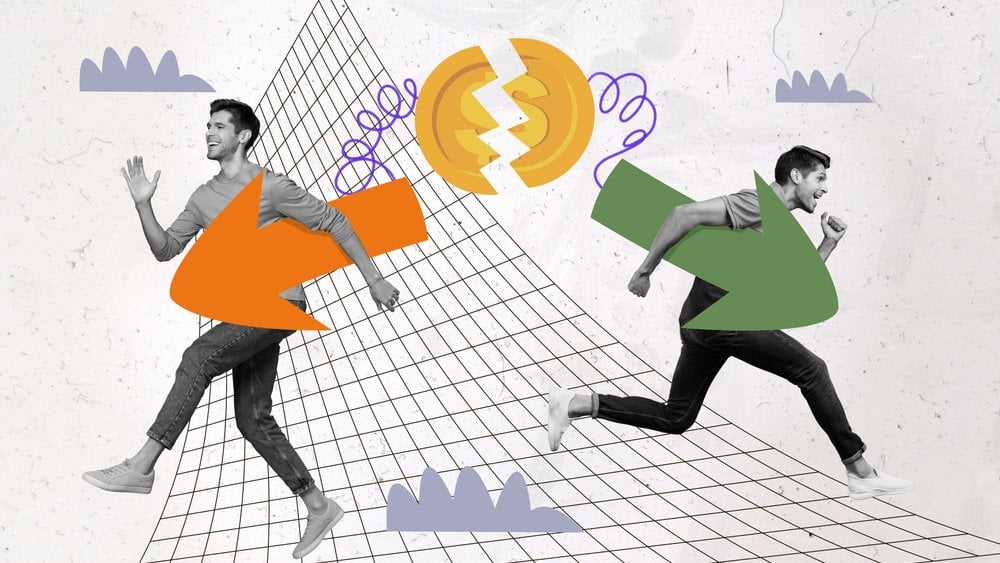This piece originally appeared in FIN, James Ledbetter’s fintech newsletter.
Very high up on the list of jobs I’ve been adjacent to but am SO glad to never hold is daily stock market commentator. Granted, telling people why the market goes up or down on a given day can be a lucrative business, as long as you are willing to abandon any consistent relationship to truth.
The reality is that most modern market behavior is too large and diverse to lend itself to neat summary. Sure, there are Pearl Harbor days when it’s obvious why stocks trade as they do. But most days, market activity is ambiguous, multifaceted and unknowable, which pushes commentary to vague cliches; the market “skyrockets” or “plummets,” as do individual stocks, except when they “hover.” More challenging and embarrassing are the explanations when the market goes down. “There were more sellers than buyers” is a shopworn go-to, which on one important level makes zero sense; every transaction requires a buyer and a seller. The oft-heard “profit-taking” is a subtler, but no more valid, explanation; it implies that investors have rationally and collectively decided, within a defined time frame, that their gains off a stock or stocks are sufficient, and they sell to lock in those profits. But it’s unclear how such sales look any different to an external observer than, um, just ordinary stock sales—some of which have been at a loss. The only way to authentically report these movements would be to have real-time access to the algorithms of a handful of market-making institutional traders; absent that, CNBC and various stock sites just fill space with so much blather.

Even so, at least stocks are regulated securities that trade on established exchanges; the idea of producing timely market commentary on cryptocurrency is even more dubious. And yet, when you’ve got an asset class worth $2 trillion, people will be tempted toward those same beloved market cliches—which is how the world ends up with headline gems like this week’s from Crypto Briefing “Bitcoin, Ethereum Uptrend Tempered by Profit Taking.”
It’s less that the commentators are obviously wrong than that the overwhelming evidence of cryptocurrency market history argues that it is impossible to know one way or another. Take “uptrend,” an admirably slippery word. Certainly, since the beginning of crypto trading or since the beginning of 2021, Bitcoin and Ethereum have pursued an “uptrend.” Start the clock in March or April of this year, however, and they have been on a “downtrend,” which might be the result of “profit taking,” or lots of other factors (such as increasing regulatory scrutiny or concerns about crypto’s effect on the environment). The interesting wrinkle in crypto market commentary is the ostensible visibility that commentators have into the wallets of Bitcoin “whales,” the activity of which is said to indicate or predict price movements. That was the basis for the Crypto Briefing story; blockchain analyst Will Clemente, whose Twitter profile says he is 19 years old, had noticed that something like 27,000 Bitcoin had moved from whale wallets to exchanges, and that is supposed to be a big bear signal to markets, because illiquid supply is associated with higher prices and liquid supply is associated with lower prices. Maybe, but on the morning of Sunday August 29 as FIN was sent out, the price of Bitcoin is higher than it was on August 25, when the Crypto Briefing article was published. The best conclusion seems to be that profit taking makes crypto prices go down—until it doesn’t.
All of this analysis needs to be taken with gigantic grains of salt. To be fair to Crypto Briefing, its CEO Mitchell Moos recently wrote: “Crypto is still a very new asset class and the industry changes very quickly. Looking back at the top 10 coins on Coinmarketcap in early 2018, only five are still in the top 10 today, and 2 of them are not even in the top 20 anymore.” That kind of perspective is crucial to understanding how little can be reliably predicted about these markets.

Can’t Get No Customer Satisfaction
Customer satisfaction in the fintech space can be pretty hard to wrap your head around. Maybe that is largely a function of the space’s novelty and rapid change. Nevertheless, one encounters a fair amount of data that seem on their face contradictory. For example, last week FIN wrote about the potentially high amount of fraud that took place with PPP loans routed through fintechs as opposed to traditional lenders. You might assume that people who got loans through fraudulent means would be pretty happy with their experience. And perhaps they were, but what little data we have on PPP recipients who got their money through fintech companies is not especially positive.

A similar head-scratching dynamic exists with credit cards and Buy Now, Pay Later. Obviously in several large countries, BNPL is a payment option that tens of millions of customers have begun using just in the last couple of years. Much of that uptake has to do with dissatisfaction with credit cards, which has increased since the COVID pandemic struck. According to a J.D. Power survey issued earlier this month:
The industry missed the mark on supporting customers’ changing needs when many were facing significant financial challenges. Whether through blunt actions, such as tightening credit limits at the very moment when customers were most reliant on their cards as a source of short-term funding, or through lack of customer service accessibility, credit card issuers experienced declines in overall satisfaction, trust, brand perception and Net Promoter Scores this year.
Despite the ripe opportunity for BNPL, however, evidence repeatedly emerges that these theoretical BNPL advantages don’t match up to how consumers actually experience and perceive BNPL. Once you can convince shoppers to use BNPL, they too often find that they can’t make the payments during the time period that makes the credit free or low-cost, and thus end up with fees that can be just as onerous as credit cards or worse. There are lots of data to support this; among the most cautionary was a study from C+R Research which found that 66% of American consumers think BNPL is “financially risky,” and 59% of those who have used BNPL say that they purchased an unnecessary item that they couldn’t otherwise afford.
This consumer wariness puts powerful limits on how BNPL can be effectively marketed to new customers (and gives pause about Square’s massive purchase of Australia’s BNPL giant Afterpay). This week, when Klarna issued a first-half earnings report, its CEO said “The credit card model is simply unsustainable for consumers, in fact, it’s unsustainable credit.” That prompted a tough retort from the financial comparison site money.co.uk, whose editor said that Klarna’s lack of visibility with credit agencies could make it a worse option for consumers.
Some of the gap between widescale consumer adoption of BNPL and dissatisfaction may stem from the fact there are different types of BNPL borrowing with different levels of consumer happiness, but that surveys dump them all into the same bucket. Regardless, it seems like BNPL is far from a panacea either for consumers or the companies trying to profit from it.
This piece originally appeared in FIN, James Ledbetter’s fintech newsletter. Ledbetter is Chief Content Officer of Clarim Media, which owns Techonomy.















